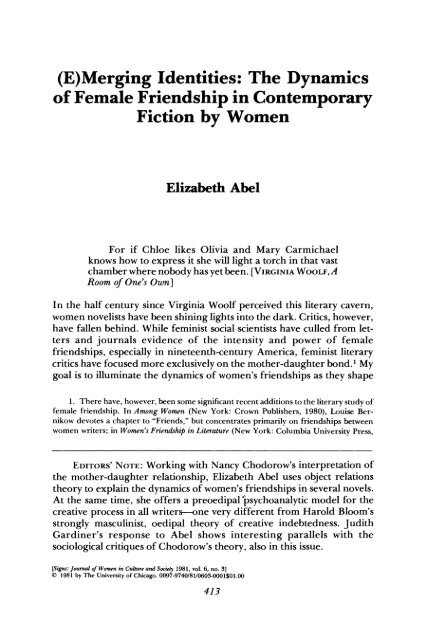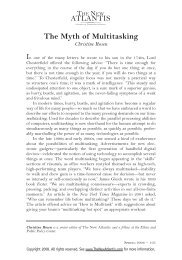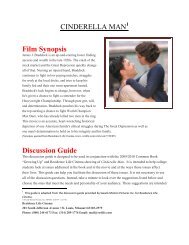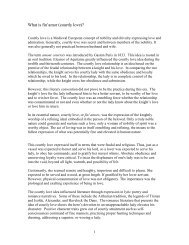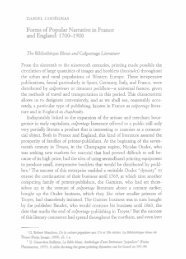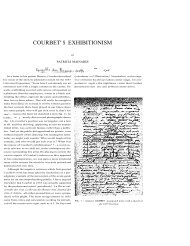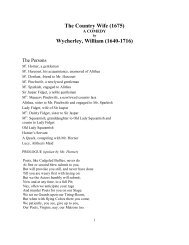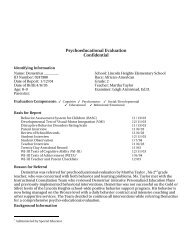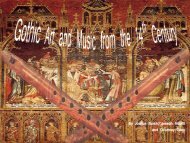(E)Merging Identities: The Dynamics of Female Friendship in ...
(E)Merging Identities: The Dynamics of Female Friendship in ...
(E)Merging Identities: The Dynamics of Female Friendship in ...
Create successful ePaper yourself
Turn your PDF publications into a flip-book with our unique Google optimized e-Paper software.
(E)<strong>Merg<strong>in</strong>g</strong> <strong>Identities</strong>: <strong>The</strong> <strong>Dynamics</strong> <br />
<strong>of</strong> <strong>Female</strong> <strong>Friendship</strong> <strong>in</strong> Contemporary <br />
Fiction by Women <br />
Elizabeth Abel<br />
For if Chloe likes Olivia and Mary Carmichael<br />
knows how to express it she will light a torch <strong>in</strong> that vast<br />
chamber where nobody has yet been. [VIRGINIA WOOLF, A<br />
Room <strong>of</strong> One's Own]<br />
In the half century s<strong>in</strong>ce Virg<strong>in</strong>ia Woolf perceived this literary cavern,<br />
women novelists have been sh<strong>in</strong><strong>in</strong>g lights <strong>in</strong>to the dark. Critics, however,<br />
have fallen beh<strong>in</strong>d. While fem<strong>in</strong>ist social scientists have culled from letters<br />
and journals evidence <strong>of</strong> the <strong>in</strong>tensity and power <strong>of</strong> female<br />
friendships, especially <strong>in</strong> n<strong>in</strong>eteenth-century America, fem<strong>in</strong>ist literary<br />
critics have focused more exclusively on the mother-daughter bond.' My<br />
goal is to illum<strong>in</strong>ate the dynamics <strong>of</strong> women's friendships as they shape<br />
1. <strong>The</strong>re have, however, been some significant recent additions to the literary study <strong>of</strong><br />
female friendship. In Among Women (New York: Crown Publishers, 1980), Louise Bernikow<br />
devotes a chapter to "Friends," but concentrates primarily on friendships between<br />
women writers; <strong>in</strong> Women's Fn'endship <strong>in</strong> Literature (New York: Columbia University Press,<br />
EDITORS'NOTE: Work<strong>in</strong>g with Nancy Chodorow's <strong>in</strong>terpretation <strong>of</strong><br />
the mother-daughter relationship, Elizabeth Abel uses object relations<br />
theory to expla<strong>in</strong> the dynamics <strong>of</strong> women's friendships <strong>in</strong> several novels.<br />
At the same time, she <strong>of</strong>fers a pre~edipal'ps~choanalyticmodel for the<br />
creative process <strong>in</strong> all writers--one very different from Harold Bloom's<br />
strongly mascul<strong>in</strong>ist, oedipal theory <strong>of</strong> creative <strong>in</strong>debtedness. Judith<br />
Gard<strong>in</strong>er's response to Abel shows <strong>in</strong>terest<strong>in</strong>g parallels with the<br />
sociological critiques <strong>of</strong> Chodorow's theory, also <strong>in</strong> this issue.<br />
[Signr:Jmd<strong>of</strong> Wmwn <strong>in</strong> Culture and Swiq 1981, vol. 6, no. S] <br />
O 1981 by <strong>The</strong> University <strong>of</strong> Chicago. 0097-974018110603-0001$01.00


